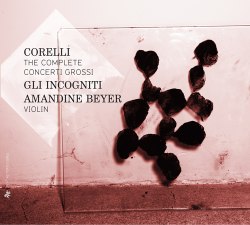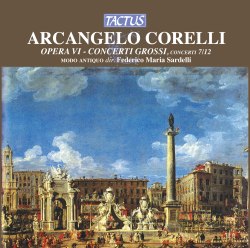|


|
Arcangelo CORELLI (1653-1713)
Concerti Grossi, Op.6 (1714)
Gli Incogniti/Amandine Beyer (violin)
rec. live Arsenal, Metz, France, 10-11 February 2012 with patch sessions, 11-13 February 2012. DDD.
Track details at end of review
Reviewed as lossless (flac) download with pdf booklet
ZIG-ZAG TERRITOIRES ZZT327 [69:29 + 75:24]
Concerti Grossi, Op.6/7-12
Modo Antiquo/Federico Maria Sardelli
rec. c.1997. Location not stated. DDD.
Track details at end of review
Reviewed as lossless (flac) download (also available in mp3)
TACTUS TC650308 [63:28]
Just when I had got it pretty firmly sorted out that the best recording of Corelli’s Op.6 concertos, not only on the grounds of performance but also because it’s offered effectively as 2-for-1, comes from the Avison Ensemble on Linn CKD411 (2 SACDs, mp3, 16- and 24-bit downloads – review) along come a new recording and a reissue to make me think all over again.
Modo Antiquo present the first recorded performance with the addition of ripieno trumpets, oboes and flutes, a practice which modern research suggests was common in Rome in Corelli’s time, though nowhere indicated in the published editions of these concertos. Whether or not these particular concerti grossi would have been performed in this way we shall never know and I’m no more qualified to get involved in the debate than anyone who reads Federico Sardelli’s persuasive notes in the booklet.
What I can say is that the results sound convincing, especially as the performances are sharply delineated and sympathetic and the additions are not overdone. Nothing in these performances is in bad taste or contrary to the spirit of the music. Try listening to No.8, the ‘Christmas’ concerto, especially the familiar pastoral finale, from Naxos Music Library if you can.
Perhaps these enhanced versions are not for hearing every time, but they certainly serve well as an adjunct to the Avison Ensemble or if you have an earlier collection such as those directed by Trevor Pinnock (DG Archiv 4749072, 2 mid-price CDs), Roy Goodman (Hyperion 2-for-1 CDD22011), Nicholas McGegan (Harmonia Mundi – review*: now download only) or Chiara Banchini (Harmonia Mundi Gold HMG501406/7, 2 lower-mid-price CDs; also Nos. 5-8, 11-12 on 2971407, download from eclassical.com). If you are just looking for a selection – six concertos out of the twelve, including the best-known, No.8 – the Banchini download could be just what you want.
* I see that, very stupidly, I referred to Trevor Pinnock as Simon Preston in that review.
The statement in the Tactus booklet (P) 2006 is somewhat misleading; I understand that the recordings were made in the 1990s – there’s certainly a review of them dating from 1999. Only this second volume is available online – the CD containing Nos.1-6, which I haven’t heard, is on TC650307; all twelve concerti have recently been reissued as a mid-price 2-CD set, TB650391.
I listened to both the mp3 and 16-bit lossless recordings, the latter equal to the CD sound and both are good enough that there need be no hesitation on that score. So that’s it: the Avison Ensemble or one of the earlier recordings that I’ve mentioned, if you already have one of them, for everyday listening, with the Tactus recording for occasional twopenny-coloured occasions. QED.
Except that the new complete recording also requires attention, from Gli Incogniti directed from the violin by Amandine Beyer on Zig-Zag Territoires ZZT327 (2 mid-price CDs for around £18.50). In addition to the twelve Op.6 concertos – rather short value on two CDs on their own – the Zig-Zag set adds a Sinfonia in d minor and a 4-part Sonata, both works without opus numbers that sit well with the Concerti Grossi.
The performances are as stylish as those from the Avison Ensemble and as forthright and sharply delineated as those from Modo Antiquo, which leaves me with my previously secure recommendation now less unshakeable. For ‘straight’ versions without added instrumentation both the Linn and the Zig-Zag recordings have much to commend them. If you like the full measure of silent meditation from the pastoral movement of No.8, you may find Gli Incogniti a little too brisk, though only a few seconds faster than Modo Antiquo and the Avison Ensemble – both fairly brisk here, too, if you got used to this work from an older recording. That’s my only reservation and it’s minor.
If you just want a selection – Nos. 5, 11, 6, 12, 7 and ending with the Christmas Concerto, No.8, which gives its name to the album as a whole – the Harmonia Mundi selection from Ensemble 417 and Chiara Banchini will do very nicely, but bear in mind that you can have the complete set of twelve on Harmonia Mundi Gold or with the Avison Ensemble from Linn for just a little more.
If you want the pastoral movement of No.8 sentimentally performed, look elsewhere – perhaps to Herbert von Karajan’s Berlin Phil recording of baroque Christmas concertos on mid-price DG 4190462. Stylish this big-band recording is not but it’s useful as a reminder of what used to pass for baroque performances, as on the Supraphon LP from which I got to know six of these Op.6 concertos. It’s not just a matter of tempo – Karajan and even Karl Münchinger, whose recording of this work is available as a download, are only a little slower than Modo Antiquo – but their whole approach is heavier. The Münchinger recording was described in 1961 as clean, crisp and stylish – interpretations of Corelli have moved on a good deal since then.
Linn give you the concertos in the published order whereas Zig-Zag re-order them as 7-9-Sinfonia in d minor-4-11-2-8-6-Sonata a 4-10-5-12-3-1. I can see the logic of alternating sonate da chiesa and sonate da camera and ending CD 1 with the famous Christmas Concerto, but Corelli surely had reasons for his arrangement. He had been very specific about the details of publication in his 1712 contract with his Dutch publisher, Estienne Roger.
Both recordings are first class. Linn offer more options than Zig-Zag – SACD, as per my review, 16- and 24-bit lossless – and their set comes with a price advantage, apart from the classicsonline.com price anomaly mentioned below, which I assume to be a temporary glitch. The good news from Linn is that the Avison Ensemble have recorded a series of Corelli’s music: the Op.5 Sonatas are on CKD412 – review – and Opp.2 and 4 on CKD413: A Recording of the Month – review.
The Zig-Zag album can be downloaded in mp3 and 16-bit lossless flac from classicsonline.com, complete with pdf booklet. Oddly, at the time of writing the higher-quality flac costs considerably less than the mp3 (£8.59 and £15.98 respectively). I’ve notified Naxos about the anomaly but you may still be lucky and find the higher-quality version for less. The only snag is that, as with all lossless flac files from classicsonline.com, each of the two CDs comes as one long file and you need a programme like medievalsplitter to divide the separate works.
No allowances have to be made for the sound of historically-informed playing on any of the recordings that I have mentioned. If, however, period instruments don’t appeal, Neville Marriner adopts a light touch with the Academy of St Martin in the Fields on Double Decca 443 8622, two CDs available for around £9. Also in the budget category and light-ish in touch are performances on Naxos from Capella Istropolitana and Jaroslav Kr(e)cek (Nos. 1-6 on 8.550402 and 7-12 on 8.550403. No.8 is also available on a CD of Christmas Concerti, Naxos 8.550567).
My own listening choice now lies between the Avison Ensemble on Linn and the new Gli Incogniti recording on Zig-Zag, with Modo Antiquo on Tactus as a luxury extra that you might want to listen to for a change. If you just want six of the best concertos, the Ensemble 417/Harmonia Mundi selection offers a good alternative. Whichever you choose, no collection of baroque music is complete without at least one recording of this wonderful music.
Brian Wilson
Previous review (ZigZag): Dominy Clements
 |
 |
|
